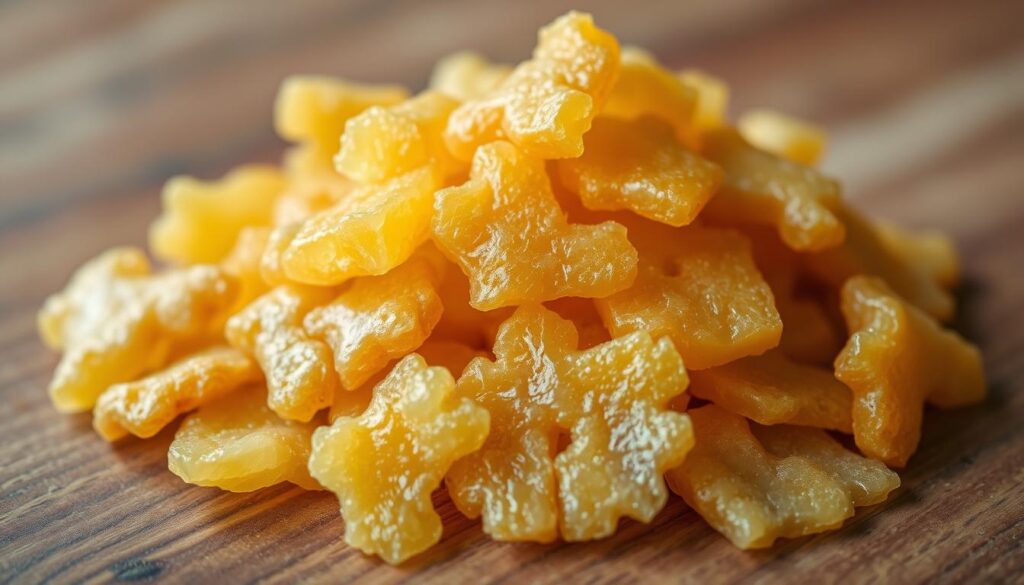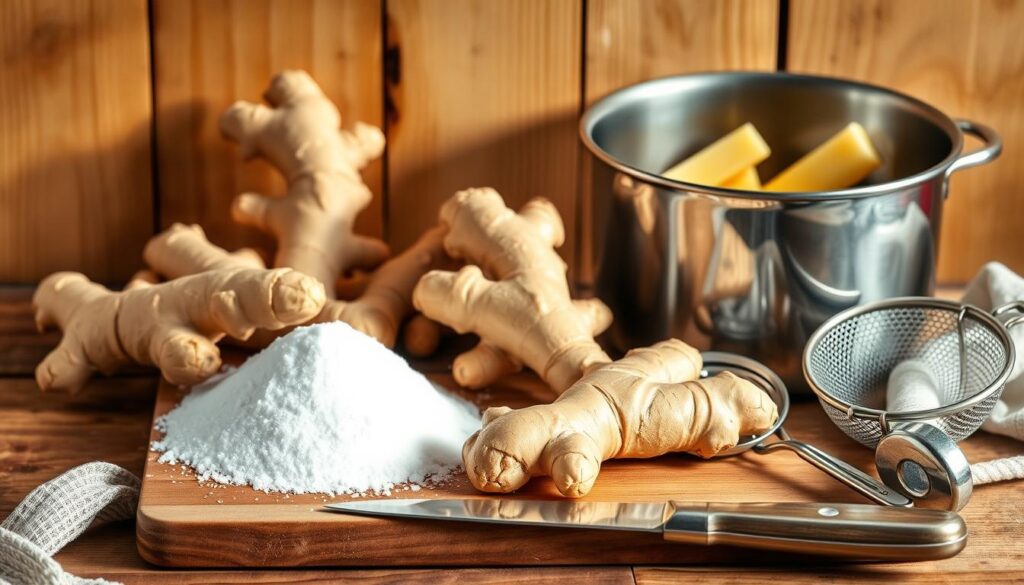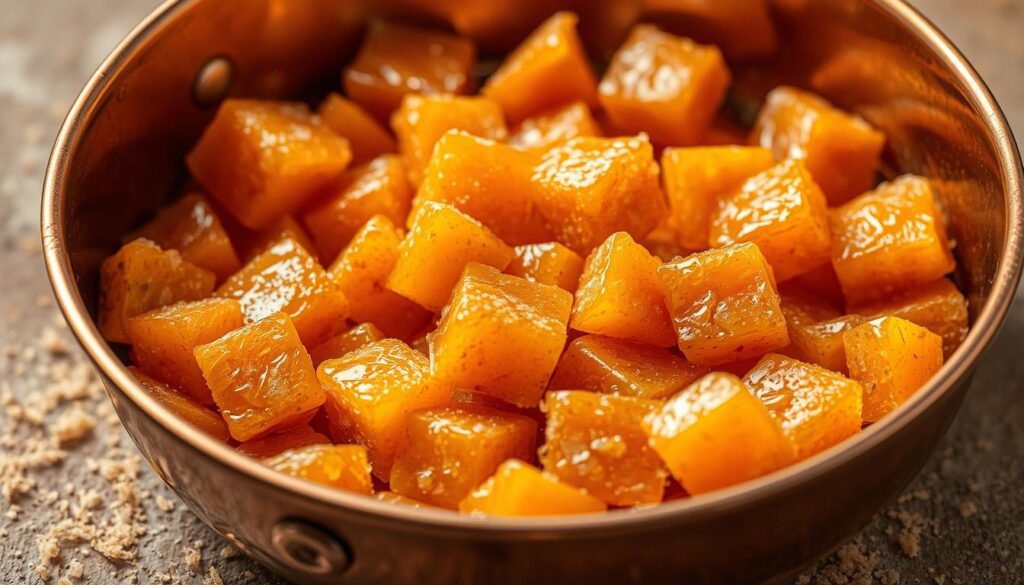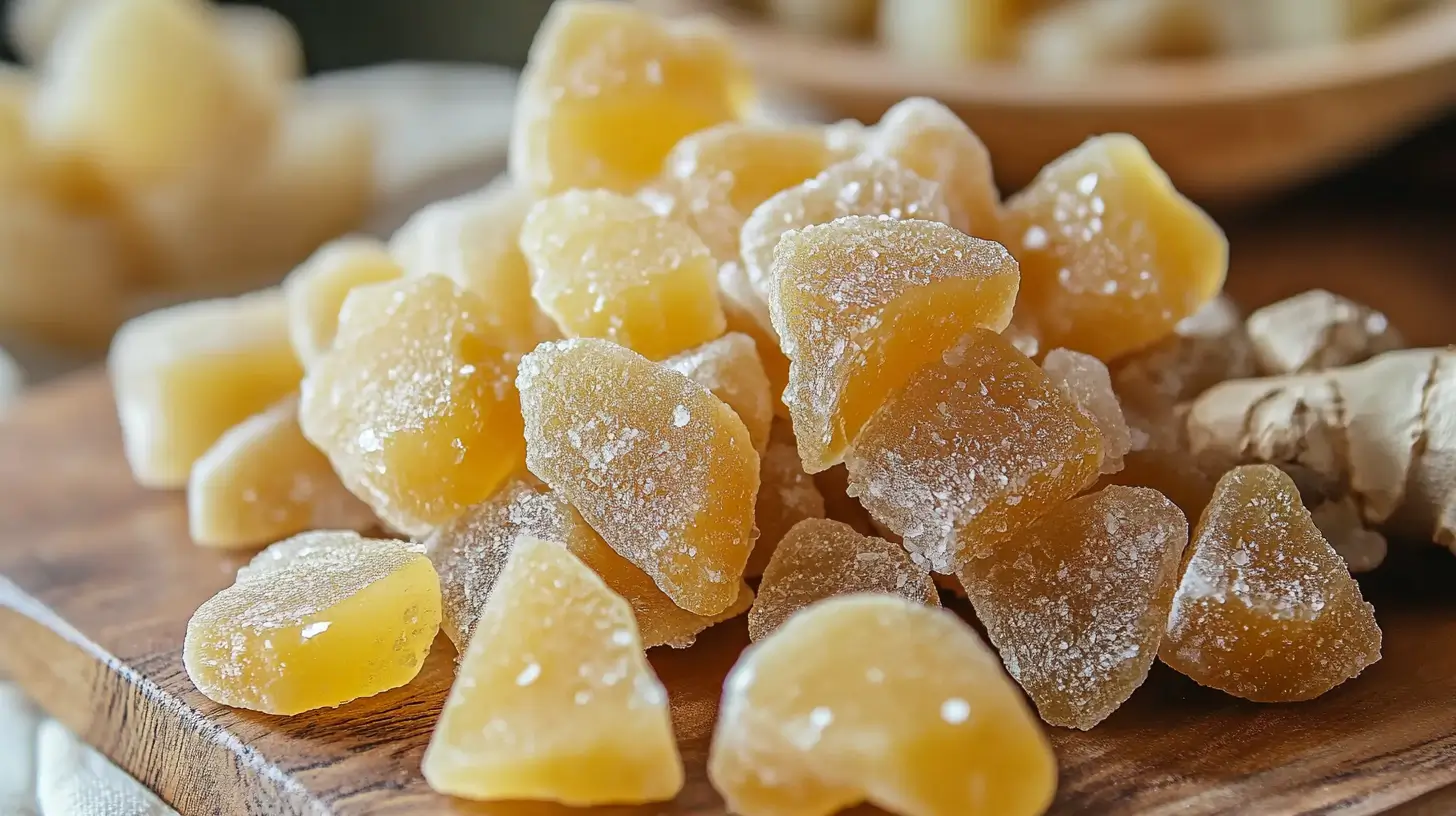How to make crystallized ginger: Ever thought about turning a simple ginger root into a sweet, spicy treat? Making crystallized ginger is more than a recipe. It’s a journey that connects you to ancient food traditions.
Ginger has been a kitchen staple for over 5,000 years, starting in Southeast Asia. The art of making crystallized ginger began in Europe’s Middle Ages. This recipe opens a world of flavors and health benefits in your kitchen.
Whether you’re a home cook or a health enthusiast, making crystallized ginger is easy and rewarding. Get ready to see how this ancient ingredient can change your cooking.
Key Takeaways
- Crystallized ginger has a rich history dating back thousands of years
- Young ginger works best for this recipe due to its milder flavor
- Homemade crystallized ginger offers more health benefits than store-bought versions
- This versatile ingredient can be used in multiple culinary applications
- Making crystallized ginger is an easy and fun cooking project
Understanding Crystallized Ginger and Its Benefits
Crystallized ginger is more than a tasty treat. It’s packed with flavor and health benefits. Making your own candied ginger connects you to a long tradition of medicine and cooking.
Historical Roots in Traditional Medicine
Ginger has been used for thousands of years. Ancient cultures saw its healing power. They used crystallized ginger to treat many health issues.

Modern Health Benefits
Today, science shows ginger’s many health benefits. Studies have found:
- Reducing inflammation
- Supporting digestive health
- Alleviating motion sickness
- Potentially lowering blood sugar levels
| Health Benefit | Research Findings |
|---|---|
| Weight Management | Reduced body weight and waist-hip ratio in overweight individuals |
| Blood Sugar Control | Significant reductions in fasting blood sugar after consuming 2 grams daily |
| Cholesterol Levels | Decreased triglycerides and LDL cholesterol |
Culinary Applications
Your homemade candied ginger is not only healthy but also versatile. Chefs and home cooks alike love it for adding flavor to both sweet and savory dishes.
Whether making your own crystallized ginger or exploring its uses, it brings a unique mix of taste, tradition, and health benefits.
Essential Ingredients and Equipment Needed

To make ginger candy at home, you need certain ingredients and tools. Knowing the crystallized ginger process starts with the right equipment and quality ingredients. Let’s look at what you’ll need to turn fresh ginger into a sweet treat.
Key Ingredients
- Fresh ginger root: Young, smooth-skinned ginger works best
- Granulated white sugar
- Water
Essential Equipment
- Heavy-bottomed saucepan
- Candy thermometer (recommended but optional)
- Sharp kitchen knife
- Cutting board
- Tongs or slotted spoon
- Wire cooling rack
- Airtight storage container
When picking ingredients for your ginger candy, choose fresh, high-quality ginger. Look for roots with smooth, unblemished skin and a creamy beige color. The crystallized ginger process relies on using premium ingredients for the best results.
Pro tip: Young ginger, typically available from April to early July, provides the most tender and flavorful base for your homemade candied ginger.
Your equipment should be clean and dry before starting. A sturdy saucepan ensures even heat distribution. A wire rack helps drain excess syrup during crystallization. These tools will help you make perfect ginger candy every time.
Selecting and Preparing Fresh Ginger Root
Choosing the right ginger is key to making great ginger candy. Fresh, high-quality ginger is essential for a tasty treat. It will make your cooking experience better.
Young ginger is best for making crystals. From April to early July, you’ll find the tenderest and tastiest roots. Look for ginger with smooth, thin skin and a slight pink tinge – these are signs of youth and quality.
Identifying the Best Ginger
- Choose ginger with smooth, unblemished skin
- Select roots that feel firm and heavy for their size
- Avoid ginger with wrinkled or soft spots
- Opt for smaller pieces for more consistent crystallization
Cleaning Techniques
Cleaning ginger right is important. Rinse it well under cool water. Use a soft brush to get rid of dirt. Then, dry it with a clean towel before peeling.
Peeling and Slicing Methods
The spoon method is great for peeling ginger. Use a spoon to scrape off the skin without wasting the flesh. For your ginger candy, slice the ginger into 1/8 inch thick pieces.
- Hold a spoon at a 45-degree angle
- Scrape against the ginger skin
- Use a sharp knife for precise, even slicing
- Ensure consistent thickness for even cooking
Pro tip: Fresh ginger can last up to a month in the fridge. For longer storage, freeze it. This can keep it fresh for up to 6 months.
How to Make Crystallized Ginger
Making crystallized ginger is simpler than you might think. This guide will show you how to make a tasty treat. It’s perfect for adding flavor to your cooking.
First, gather what you need for this homemade ginger recipe. You’ll need:
- 1 pound fresh ginger root
- 2 cups granulated sugar
- 3 cups water
- 1/2 cup additional sugar for coating
To make crystallized ginger, follow these steps:
- Prepare the ginger by washing and peeling the root
- Slice the ginger into thin, uniform pieces
- Boil the ginger in water for 15 minutes
- Simmer the ginger in sugar syrup for 45 minutes
- Drain and dry the ginger slices
- Coat with additional sugar
For the best results, remember these tips:
- Use young ginger for a more tender texture
- Slice ginger as evenly as possible for consistent cooking
- Use a candy thermometer to ensure proper sugar syrup temperature (225°F)
- Turn ginger slices while drying for even crystallization
Your homemade crystallized ginger can be stored in an airtight container at room temperature for up to 6 weeks. Or, refrigerate it for up to 5 months. The cooking water can also be used to make a ginger-flavored simple syrup. This adds extra value to your candied ginger tutorial.
The Crystallization Process and Sugar Syrup Preparation

Making ginger candy at home needs care and time. The process turns regular ginger into a sweet treat that excites your taste. Knowing how to make the sugar syrup is crucial for perfect ginger candy.
When you mix fresh ginger with sugar syrup, magic happens. You aim to make a sweet, clear candy that brings out ginger’s special flavor.
Creating the Perfect Sugar Syrup
Getting the sugar syrup right is key. Here’s what you should do:
- Use a heavy-bottomed pot for even heat distribution
- Select high-quality granulated sugar
- Maintain a consistent heat source
Temperature Control Tips
Temperature is very important when making ginger candy. The best temperature for crystallization is 225°F (107°C). Here’s a quick guide:
| Temperature Range | Expected Result |
|---|---|
| 220-225°F | Perfect Crystallization |
| Below 220°F | Syrup Too Thin |
| Above 230°F | Risk of Burning |
Visual Cues for Doneness
Your senses are great tools in making ginger candy. Look for these signs of perfect candy:
- Ginger becomes translucent
- Syrup thickens noticeably
- Sugar begins to form delicate crystals
“Patience transforms simple ginger into a culinary treasure.” – Artisan Candy Maker
With practice, you’ll get better at making amazing crystallized ginger. It will be as good as the ones you buy.
Drying and Storage Methods
Learning how to preserve your homemade candied ginger is key. This way, you can enjoy it for months. After you’ve crystallized your ginger, drying and storing it right is important. It keeps the ginger tasting great and fresh.
Drying your ginger is all about getting the right texture. You want it to be dry and crunchy. It should snap when you bend it, not flex.
Drying Techniques
- Oven method: Dry at 80°C/176°F for approximately 2.5 hours
- Dehydrator method: Set at 40°C/100°F for 4-5 hours
- Air drying: 3-4 days in a dry, sunny environment
Storage Recommendations
| Storage Method | Duration | Conditions |
|---|---|---|
| Room Temperature | Up to 6 weeks | Airtight glass or BPA-free plastic container |
| Refrigeration | Up to 5 months | Sealed vacuum bag or container |
| Freezer | Up to 6 months | Vacuum-sealed packaging |
When storing your candied ginger, pick a cool, dark spot. A pantry or cupboard works well. Keep an eye out for any signs of spoilage. If it gets soft or smells off, it’s gone bad.
By using these storage tips, you’ll keep your candied ginger tasty and fresh. Enjoy it for weeks to come.
Creative Ways to Use Your Homemade Crystallized Ginger
Once you’ve made your own crystallized ginger, you’ll see how versatile it is. It can turn simple dishes into something special.
Your homemade crystallized ginger is perfect for many recipes. It adds a spicy-sweet flavor that makes dishes stand out.
Culinary Applications
Use your ginger in different ways to add depth to your cooking:
- Chop finely and fold into baked goods like cookies and muffins
- Sprinkle over salads for unexpected zest
- Use as a garnish for roasted vegetables
- Mix into homemade granola for extra flavor
Beverage Enhancements
Crystallized ginger can make your drinks even better:
- Steep in hot tea for warming comfort
- Muddle in cocktails for sophisticated complexity
- Add to smoothies for a spicy kick
- Garnish hot chocolate or coffee
Dessert Innovations
Try new desserts with your homemade crystallized ginger:
- Create ginger-chocolate truffles
- Top ice cream with chopped pieces
- Incorporate into cheesecake crusts
- Blend into homemade sorbet
Pro tip: Always store your crystallized ginger in an airtight container. This keeps its texture and prevents moisture absorption.
Troubleshooting Common Issues
Making the perfect ginger candy can be tricky. Even skilled cooks face problems with crystallized ginger. But, most issues have easy fixes!
When you’re following your candied ginger tutorial, keep an eye out for these common problems:
- Ginger becoming too hard or tough
- Syrup crystallizing too soon
- Uneven sugar coating
- Sticky texture issues
Pro tip: Temperature control is key in your ginger candy recipe. If your ginger is too hard, it might have been cooked too long or at too high a temperature. Try lowering the heat and cooking for less time to get a softer texture.
For sticky ginger, here are some quick solutions:
- Dust extra sugar on the surface
- Let it dry for longer
- Spread pieces separately while cooling
“Practice makes perfect with crystallized ginger – don’t get discouraged by initial setbacks!”
If your sugar syrup crystallizes too fast, make sure to use clean tools. Also, avoid sugar crystals on the pan’s sides. Adding a bit of corn syrup can help stop early crystallization in your ginger candy recipe.
Conclusion
Learning to make crystallized ginger is more than a skill. It’s a journey into an ancient ingredient’s world. Your homemade candied ginger connects you to a 5,000-year-old tradition, from Southeast Asia to today’s kitchens.
Mastering crystallized ginger opens up new cooking possibilities. Your treat can make baked goods better, add flavor to drinks, and be a healthy snack. It might seem hard at first, but with practice, you’ll make ginger that’s sweeter and spicier than store-bought.
Keep your candied ginger in a sealed container for up to three months. You can try different ginger types, sugar levels, and methods. Share it with loved ones, turning a simple root into a gourmet treat that shares your story.
Each piece of your homemade ginger is a victory in the kitchen. It’s a sweet, spicy proof of your cooking skills and bold spirit.
FAQs
How long does homemade crystallized ginger last?
Homemade crystallized ginger can last 3-4 months at room temperature in an airtight container. Refrigeration extends its life to 6 months. Always check for moisture or mold before eating.
Can I use old or mature ginger for crystallizing?
Mature ginger can be used, but young ginger is better. Young ginger is tender, less fibrous, and has a milder taste. If using mature ginger, peel it carefully and cook it longer to soften.
Is crystallized ginger good for you?
Yes, crystallized ginger is good for you. It has anti-inflammatory properties, aids digestion, and can reduce nausea. But, it’s high in sugar, so eat it in moderation.
What equipment do I need to make crystallized ginger?
You’ll need a sharp knife, cutting board, saucepan, candy thermometer, baking sheet, and wire rack. A spoon for peeling and a clean towel for drying are also helpful.
Can I use alternative sweeteners instead of white sugar?
White sugar is best for traditional crystallized ginger. But, you can try raw or coconut sugar. These may change the texture and look. White sugar works best for crystallization.
How spicy will homemade crystallized ginger be?
The spice level depends on the ginger type and preparation. Young ginger is milder, while mature ginger is spicier. Soaking or boiling the ginger can make it less spicy.
What are some ways to use crystallized ginger?
Crystallized ginger is very versatile. Use it in baked goods, as a dessert garnish, in tea, cocktails, savory dishes, or as a snack.
How do I prevent my crystallized ginger from becoming too sticky?
Dry the ginger well after sugar coating. Let it dry on a wire rack in a cool, dry place for hours. Rolling it in more sugar can also help.


1 thought on “How to Make Crystallized Ginger”